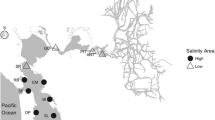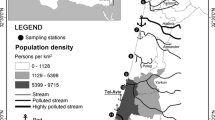Abstract
We carried out a two-part investigation that revealed habitat differences in marine invertebrate invasions. First, we compared invasion levels of hard vs soft substrata in Elkhorn Slough, an estuary in Central California, by comparing abundance and richness of native vs exotic species in quantitative samples from each habitat type. Our results revealed that the hard substrata were much more heavily invaded than the soft substrata. Nearly all the hard substrata in Elkhorn Slough, as in most estuaries along the Pacific coast of North America, are artificial (jetties, rip-rap, docks). Some exotic species may by chance be better adapted to this novel habitat type than are natives. Two major vectors responsible for marine introductions, oyster culturing and ship-hull fouling, are also more likely to transport species associated with hard vs soft substrata. Secondly, we compared estuarine and open coast invasion rates. We examined species richness in Elkhorn Slough and adjacent rocky intertidal habitats along the Central California coast. The absolute number of exotic species in the estuary was an order of magnitude higher than along the open coast (58 vs 8 species), as was the percentage of the invertebrate fauna that was exotic (11% vs 1%). Estuaries on this coast are geologically young, heavily altered by humans, and subject to numerous transport vectors bringing invasive propagules: all these factors may explain why they are strikingly more invaded than the open coast. The finding that the more species rich habitat – the open coast – is less invaded is in contrast to many terrestrial examples, where native and exotic species richness appear to be positively correlated at a broad geographic scale.
Similar content being viewed by others
References
J Byers (2002) ArticleTitleImpact of non-indigenous species on natives enhanced by anthropogenic alteration of selection regimes Oikos 97 449–458 Occurrence Handle10.1034/j.1600-0706.2002.970316.x
J Byers EG Noonburg (2003) ArticleTitleScale dependent effects of biotic resistance to biological invasion Ecology 84 1428–1433
JT Carlton (1979) History, Biogeography, and Ecology of the Introduced Marine and Estuarine Invertebrates of the Pacific Coast of North America University of California Davis
JT Carlton (1996) ArticleTitleBiological invasions and cryptogenic species Ecology 77 1653–1655
Carlton JT (2001) Introduced species in U.S. coastal waters. Pew Oceans Commission Report
Cohen AN, Carlton JT (1995) Nonindigenous aquatic species in a United States estuary: a case study of the biological invasions of the San Francisco Bay and Delta. Report for the US Fish and Wildlife Service and Connecticut Sea Grant Program
AN Cohen JT Carlton (1998) ArticleTitleAccelerating invasion rate in a highly invaded estuary Science 279 555–558 Occurrence Handle10.1126/science.279.5350.555 Occurrence Handle9438847
C Elton (1958) The Ecology of Invasions by Animals and Plants Methuen London
ED Grosholz GM Ruiz (1996) ArticleTitlePredicting the impact of introduced marine species: lessons from the multiple invasions of the European green crab Carcinus maenas Biological Conservation 78 59–66 Occurrence Handle10.1016/0006-3207(94)00018-2
C Kolar DM Lodge (2001) ArticleTitleProgress in invasion biology: predicting invaders Trends in Ecology & Evolution 16 199–204
J Levine C D’Antonio (1999) ArticleTitleElton revisited: a review of evidence linking diversity and invasibility Oikos 87 15–26
DM Lodge (1993) ArticleTitleBiological invasions: lessons for ecology Trends in Ecology & Evolution 8 133–137
W Lonsdale (1999) ArticleTitleGlobal patterns of plant invasions and the concept of invasibility Ecology 80 1522–1536
P Rawson V Agrawal T Hilbish (1999) ArticleTitleHybridization between the blue mussels Mytilus galloprovincialis and M. trossolus along the Pacific coast of North America: evidence for limited introgression Marine Biology 134 201–211 Occurrence Handle10.1007/s002270050538
GM Ruiz JT Carlton ED Grosholz AH Hines (1997) ArticleTitleGlobal invasions of marine and estuarine habitats by non-indigenous species: mechanisms, extent, and consequences American Zoologist 37 621–632
GM Ruiz P Fofonoff AH Hines ED Grosholz (1999) ArticleTitleNon-indigenous species as stressors in estuarine and marine communities: assessing invasion impacts and interactions Limnology and Oceanography 44 950–972
K Shea P Chesson (2002) ArticleTitleCommunity ecology theory as a framework for biological invasions Trends in Ecology & Evolution 17 170–176
R Smith JT Carlton (1975) Light’s manual: intertidal invertebrates of the central California coast University of California Press Berkeley
TJ Stohlgren D Binkley GW Chong MA Kalkhan D. Lisa LD Schell KA Bull Y Otsuki G Newman M Bashkin Y Son (1999) ArticleTitleExotic plant species invade hot spots of native plant diversity Ecological Monographs 69 25–46
K Wasson C Zabin M Diaz L Bedinger J Pearse (2001) ArticleTitleBiological invasions of estuaries without international shipping: the importance of intraregional transport Biological Conservation 102 143–153 Occurrence Handle10.1016/S0006-3207(01)00098-2
M Williamson (1996) Biological Invasions Chapman and Hall London
Author information
Authors and Affiliations
Corresponding author
Rights and permissions
About this article
Cite this article
Wasson, K., Fenn, K. & Pearse, J.S. Habitat Differences in Marine Invasions of Central California. Biol Invasions 7, 935–948 (2005). https://doi.org/10.1007/s10530-004-2995-2
Received:
Accepted:
Issue Date:
DOI: https://doi.org/10.1007/s10530-004-2995-2




